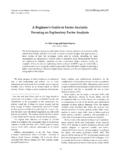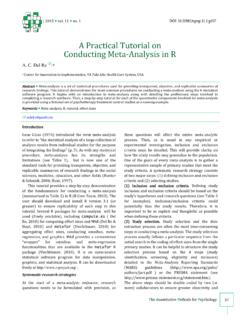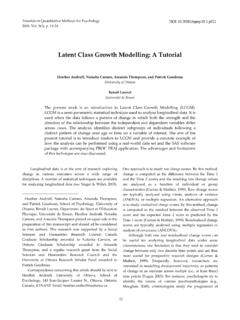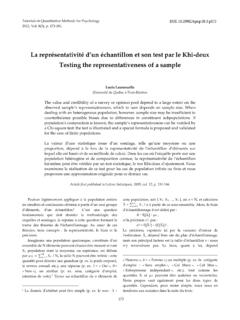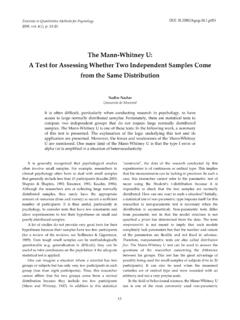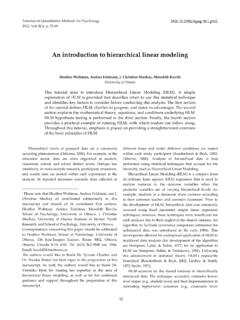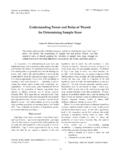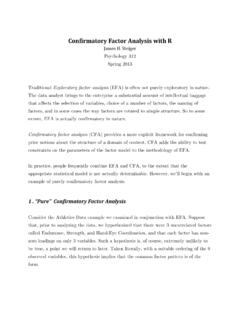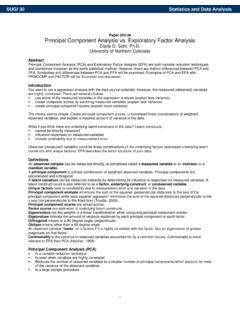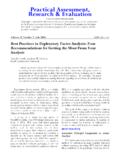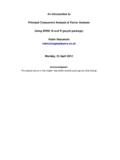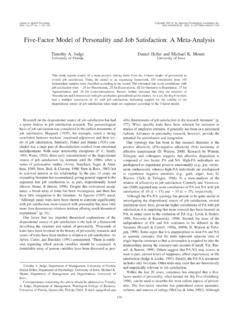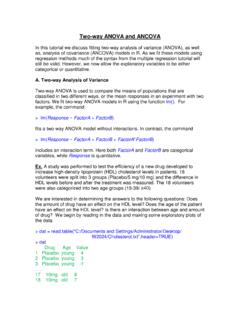Transcription of A Beginner’s Guide to Factor Analysis: Focusing on ...
1 Tutorials in Quantitative Methods for Psychology 2013, Vol. 9(2), p. 79-94. 79 A Beginner s Guide to Factor analysis : Focusing on exploratory Factor analysis An Gie Yong and Sean Pearce University of Ottawa The following paper discusses exploratory Factor analysis and gives an overview of the statistical technique and how it is used in various research designs and applications. A basic outline of how the technique works and its criteria, including its main assumptions are discussed as well as when it should be used.
2 Mathematical theories are explored to enlighten students on how exploratory Factor analysis works, an example of how to run an exploratory Factor analysis on SPSS is given, and finally a section on how to write up the results is provided. This will allow readers to develop a better understanding of when to employ Factor analysis and how to interpret the tables and graphs in the output. The broad purpose of Factor analysis is to summarize data so that relationships and patterns can be easily interpreted and understood.
3 It is normally used to regroup variables into a limited set of clusters based on shared variance. Hence, it helps to isolate constructs and concepts. Note that both Sean Pearce and An Gie Yong should be considered as first authors as they contributed equally and substantially in the preparation of this manuscript. The authors would like to thank Dr. Louise Lemyre and her team, Groupe d Analyse Psychosociale Sant (GAP-Sant ), for their generous feedback; in particular, Dr.
4 Lemyre who took the time to provide helpful suggestions and real world data for the tutorial. The authors would also like to thank Levente Orb n and Dr. Sylvain Chartier for their guidance. The original data collection was funded by PrioNet Center of Excellence, the McLaughlin Chair in Psychosocial Aspects of Health and Risk, and a SSHRC grant to Louise Lemyre, , FRSC, with the collaboration of Dr. Daniel Krewski. Address correspondence to An Gie Yong, Groupe d Analyse Psychosociale Sant , GAP-Sant , University of Ottawa, Social Sciences Building, 120 University Street, room FSS-5006, Ottawa, Ontario, K1N 6N5, Canada.
5 Email: Factor analysis uses mathematical procedures for the simplification of interrelated measures to discover patterns in a set of variables (Child, 2006). Attempting to discover the simplest method of interpretation of observed data is known as parsimony, and this is essentially the aim of Factor analysis (Harman, 1976). Factor analysis has its origins in the early 1900 s with Charles Spearman s interest in human ability and his development of the Two- Factor Theory; this eventually lead to a burgeoning of work on the theories and mathematical principles of Factor analysis (Harman, 1976).
6 The method involved using simulated data where the answers were already known to test Factor analysis (Child, 2006). Factor analysis is used in many fields such as behavioural and social sciences, medicine, economics, and geography as a result of the technological advancements of computers. The two main Factor analysis techniques are exploratory Factor analysis (EFA) and Confirmatory Factor analysis (CFA). CFA attempts to confirm hypotheses and uses path analysis diagrams to represent variables and factors , whereas EFA tries to uncover complex patterns by exploring the dataset and testing predictions (Child, 2006).
7 This tutorial will be Focusing on EFA by providing fundamental theoretical background and practical SPSS techniques. EFA is normally the first step in building scales or a new metrics. Finally, a basic Guide on how to write-up the results will be 80 outlined. A Look at exploratory Factor analysis What is Factor analysis ? Factor analysis operates on the notion that measurable and observable variables can be reduced to fewer latent variables that share a common variance and are unobservable, which is known as reducing dimensionality (Bartholomew, Knott, & Moustaki, 2011).
8 These un-observable factors are not directly measured but are essentially hypothetical constructs that are used to represent variables (Cattell, 1973). For example, scores on an oral presentation and an interview exam could be placed under a Factor called communication ability ; in this case, the latter can be inferred from the former but is not directly measured itself. EFA is used when a researcher wants to discover the number of factors influencing variables and to analyze which variables go together (DeCoster, 1998).
9 A basic hypothesis of EFA is that there are m common latent factors to be discovered in the dataset, and the goal is to find the smallest number of common factors that will account for the correlations (McDonald, 1985). Another way to look at Factor analysis is to call the dependent variables surface attributes and the underlying structures ( factors ) internal attributes' (Tucker & MacCallum, 1997). Common factors are those that affect more than one of the surface attributes and specific factors are those which only affect a particular variable (see Figure 1; Tucker & MacCallum, 1997).
10 Why Use Factor analysis ? Large datasets that consist of several variables can be reduced by observing groups of variables ( , factors ) that is, Factor analysis assembles common variables into descriptive categories. Factor analysis is useful for studies that involve a few or hundreds of variables, items from questionnaires, or a battery of tests which can be reduced to a smaller set, to get at an underlying concept, and to facilitate interpretations (Rummel, 1970). It is easier to focus on some key factors rather than having to consider too many variables that may be trivial, and so Factor analysis is useful for placing variables into meaningful categories.
